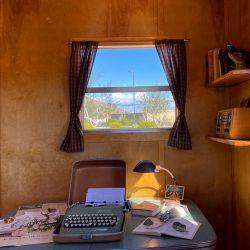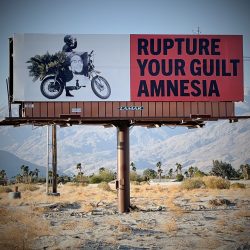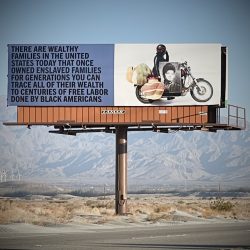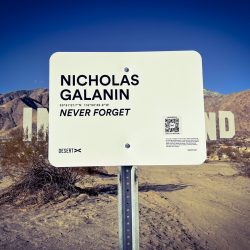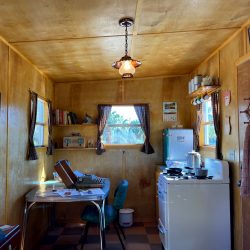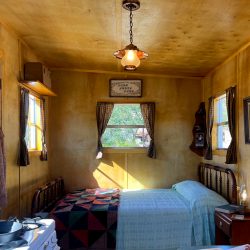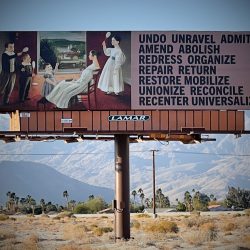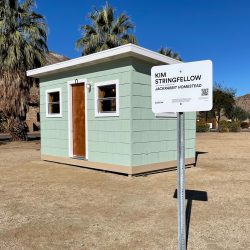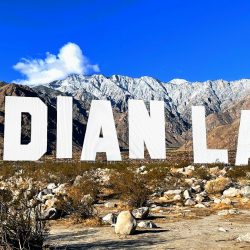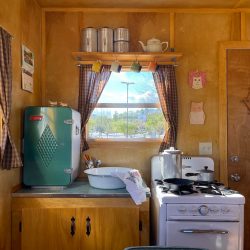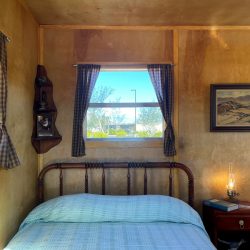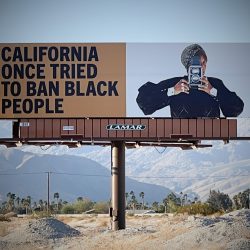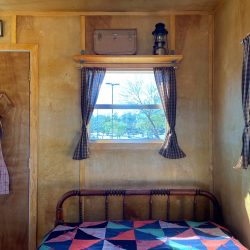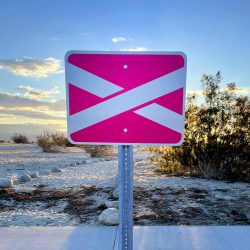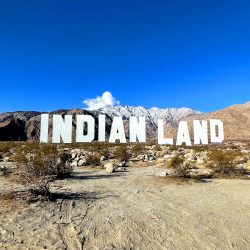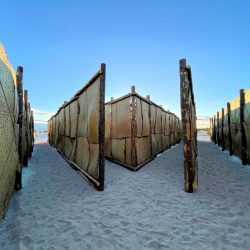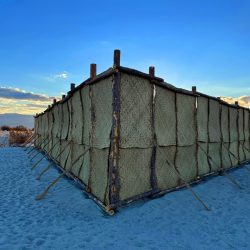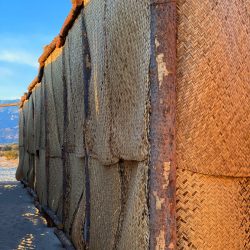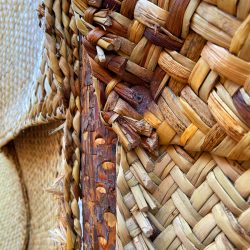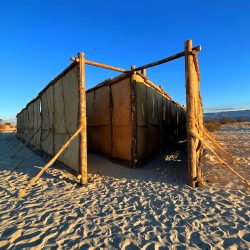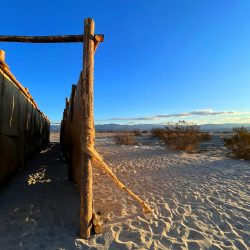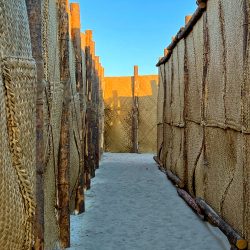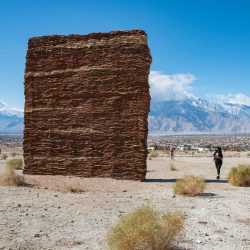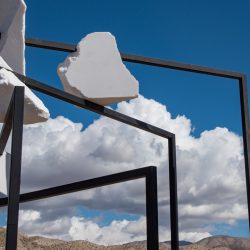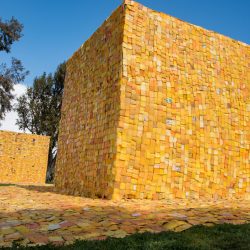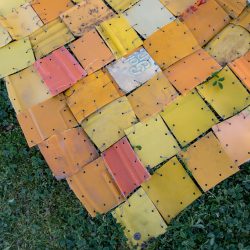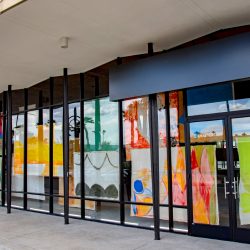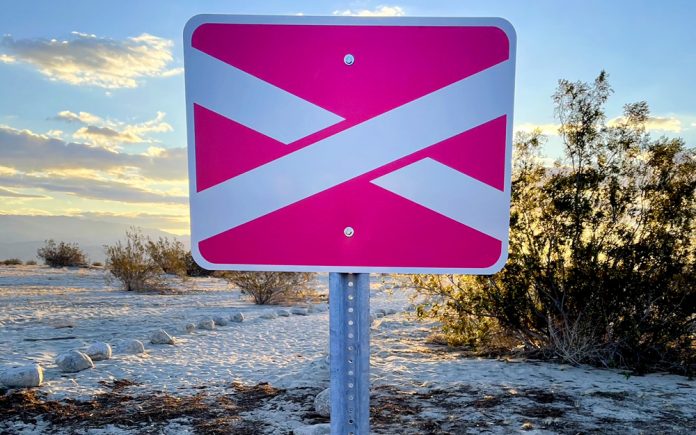
By Crystal Harrell
It’s been two years since the last Desert X art exhibition came to the Coachella Valley, and it goes without saying how much has happened within that window of time. For the 2021 installment, Desert X features 12 different works from artists around the world to bring issues like social activism, racial borders, and the pandemic to the forefront through an artistic lens.
The first Desert X took place in 2017 and included 16 artists who created works for locations from Whitewater Preserve to Coachella. The second exhibition in 2019 featured 18 artists that spanned all the way to the Salton Sea. In 2020, the organization engaged in its first exhibition outside the United States and helped realize a project in the AlUla desert of Saudi Arabia, bringing together artists from across that region as well as those from Europe and the U.S.
“For Desert X 2021, we took our cues from the way deserts are formed, from the natural processes that weather their surfaces and expand their geographies. Acting upon this place, the projects seek to identify and uplift lesser known and complex stories of immeasurable impact through conversations between the lived experience of people here with those who came before them and the realities that we live in now. We refute the dichotomy of local versus global, and instead champion the nuances that connect both,” said co-curator César García-Alvarez.
What Lies Behind the Walls, by artist Zahrah Alghamdi from Saudi Arabia, creates a monumental sculptural wall that connects the desert landscape of the Coachella Valley to the transformations of other deserts across the globe in a unified front. Her creative process involves assembling particles of earth, clay, rocks, leather, and water to craft themes of cultural identity and loss.
Ghada Amer continues her Women’s Qualities series, spurred by asking men and women in the Coachella Valley to share words that describe the qualities with which they identify and have been described as being. Women’s Qualities is presented as a grouping of words arranged on the circular Great Lawn at Sunnylands to create a tranquil space of contemplation and community.
Felipe Baeza’s Finding Home in My Own Flesh acknowledges the Coachella Valley as both a border region and a queered space, and honors immigrants and queer people of color who have been an integral part of the region’s story. The Mexican artist’s piece depicts two hands enveloping a cloud of vines and flowers, representing the erasing of marginalized people from official narratives and collective consciousness.
The Wishing Well is a sculptural installation of large-scale cubes draped with sheets of woven pieces of yellow plastic Kufuor gallons used to transport water in Ghana. This installation by artist Serge Attukwei Clottey refers to the wells to which many people around the world must trek daily to access water, emphasizing themes of colonial pillaging and its effects on trade and migration.
Alaskan artist Nicholas Galanin’s Never Foget is among the most popular additions to this year’s Desert X. The 45-foot letters depicting “Indianland” reference the Hollywood sign, and represent the cultural intersection of Indigenous communities and the American mythology of “land of the free”.
Alicja Kwade’s ParaPivot (sempiternal clouds) consists of interlocking frames supporting large blocks of white marble that appear as ice calved from a distant glacier. The array of steel and stone draws viewers into the frame of the massive, yet fragile, universe where simple forms yield meanings of wobbling perception of size and relationship. There is a steep 15 minute walk up to this art installation in Sky Valley, as well as a timed ticket requirement to visit the installation from Thursday to Sunday. Free tickets can be reserved on the Desert X website.
Colombian artist Oscar Murillo’s Frequencies is a long-term collaborative project with students and schools from around the world. Desks in participating classrooms are covered with a blank canvas that students are encouraged design in whatever way they wish. The canvases are meant to become an index of a period in a student’s life over time. Hundreds of students from Coachella Valley schools received a canvas and art supplies to participate.
Argentinian artist Vivian Suter’s Tamanrasset is an installation of large-scale abstract paintings and light inspired by the Coachella Valley landscape in Palm Springs. Due to travel restrictions, Suter was unable to conduct a site visit to the desert and instead explored the ways the region existed in pictures. The end result reflects the colorful, emotional dimensions of the desert landscape.
New York artist Christopher Myers’ installation, The Art Of Taming Horses, will be on view after April 9 in Palm Springs. The sculptures with draping banners will tell the story of two ranchers—one Mexican and one African-American—whose personal adversities and love for raising horses led them to create a welcoming community in the place that eventually would become Palm Springs.
California artist Eduardo Sarabia’s The Passenger is an arrow tip-shaped maze inspired by the stories of journeys through the desert that has permeated throughout generations. The Passenger acknowledges the many people who have passed through the Coachella Valley while offering visitors time to contemplate their own journey as they navigate the maze. To ensure social distancing, timed tickets are required to visit this installation. Only 15 guests are permitted per half hour to visit.
New York artist Xaviera Simmons’ Because You Know Ultimately We Will Band A Militia stretches across a series of billboards on Gene Autry Trail in Palm Springs, and its cornerstone themes are reverence, resistance, and the redistribution of tangible material resources. Simmons’ art spans from photography to performance, as well as installation, video, and sound works.
California artist Kim Stringfellow’s Jackrabbit Homestead is found adjacent to the Palm Desert Chamber of Commerce. The 122-square-foot cabin she created plays an audioscape collaboration between herself, Georgia-based musician/artist/author Jim White, and fellow Georgian singer/songwriter Claire Campbell. Catherine Venn Peterson can be heard chronicling her 1950 homesteading experience while replica home furnishings can be seen through the windows.
A special Desert X printed program is available at the Desert X Hub at the Ace Hotel & Swim Club, containing up-to-date information on how to experience the exhibitions and its public and education programs safely in compliance with CDC, State, and County regulations. The map of the 2021 installations can also be found online at desertx.org and via the Desert X 2021 app.
“More so than ever, Desert X 2021 is an exhibition for our times. The curators have brought together an extraordinary group of international artists who have made compelling works that celebrate the Coachella Valley and its histories while provoking us to explore our commonalities and celebrate our differences,” stated Desert X Founder and President Susan Davis.
Desert X encourages visitors to follow official Leave No Trace guidelines: Plan ahead and prepare, walk on designated paths, dispose of waste properly, leave what you find, respect wildlife, don’t smoke, and be considerate of other visitors.
For guided tours and accommodations throughout the duration of the exhibition, please contact info@desertx.org . Docents are available to provide information at most sites every Saturday between March 12 and May 16 from 10 a.m. to noon.


































